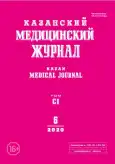Clinical case of intracardiac pacemaker lead fracture
- Authors: Kalinin RE1, Suchkov IA1, Povarov VO1,2, Shitov II2, Potehinskiy SS2, Solovov DV2, Peshkov SA2
-
Affiliations:
- Ryazan State Medical University
- Ryazan State Cardiologic Dispensary
- Issue: Vol 101, No 6 (2020)
- Pages: 908-912
- Section: Clinical observations
- Submitted: 23.09.2020
- Accepted: 30.10.2020
- Published: 14.12.2020
- URL: https://kazanmedjournal.ru/kazanmedj/article/view/44859
- DOI: https://doi.org/10.17816/KMJ2020-908
- ID: 44859
Cite item
Abstract
Lead fracture is a serious complication of a pacemaker; its prevalence is 0.1–4.2%. The common site of lead fracture is at the space between the clavicle and the first rib. The causes are intense physical activity, which approximates the clavicle to the rib and compression of the lead, chest trauma, anatomical features, twiddler’s syndrome. Diagnosis of lead fracture is can be made by electrocardiography — there is a transient or permanent stimulation/sensitivity disturbance. When the programmer interrogates the pacemaker, a significant sign is an abrupt rise in the lead impedance, although cases of fracture with normal impedance values have been reported. The article presents an extremely rare clinical case of an intracardiac lead fracture in a 28-year-old patient. At the initial implantation, leads were passed through the accessory left superior vena cava, resulting in a loop in the right ventricle. The patient himself was subjected to increased physical activity. The question of the need to remove such leads remains open. Some authors note that the distal end is firmly fixed to the heart wall, and therefore does not expose the patient to a vital risk. Others consider that the lead can become a source of thrombus formation, or fragmentation with embolism in the pulmonary circulation can occur. In our case, the causes of the fracture were probably an intense physical activity and bending of the lead inside the right ventricle. The clinical situation was discussed with cardiac surgeons of the federal centers of cardiovascular surgery. Given the high risks of open-heart surgery, it was deci¬ded to refrain from removing the broken lead, and the patient was provided with atrial pacing.
Full Text
About the authors
R E Kalinin
Ryazan State Medical University
Email: povarov.vladislav@mail.ru
Russian Federation, Ryazan, Russia
I A Suchkov
Ryazan State Medical University
Email: povarov.vladislav@mail.ru
Russian Federation, Ryazan, Russia
V O Povarov
Ryazan State Medical University; Ryazan State Cardiologic Dispensary
Author for correspondence.
Email: povarov.vladislav@mail.ru
Russian Federation, Ryazan, Russia; Ryazan, Russia
I I Shitov
Ryazan State Cardiologic Dispensary
Email: povarov.vladislav@mail.ru
Russian Federation, Ryazan, Russia
S S Potehinskiy
Ryazan State Cardiologic Dispensary
Email: povarov.vladislav@mail.ru
Russian Federation, Ryazan, Russia
D V Solovov
Ryazan State Cardiologic Dispensary
Email: povarov.vladislav@mail.ru
Russian Federation, Ryazan, Russia
S A Peshkov
Ryazan State Cardiologic Dispensary
Email: povarov.vladislav@mail.ru
Russian Federation, Ryazan, Russia
References
- Kleemann T., Becker T., Doenges K. et al. Annual rate of transvenous defibrillation lead defects in implantable cardioverter-defibrillators over a period of >10 years. Circulation. 2007; 115: 2474–2480. doi: 10.1161/CIRCULATIONAHA.106.663807.
- Bohm A., Duray G., Kiss R.G. Traumatic pacemaker lead fracture. Emerg. Med. J. 2013; 30 (8): 686. doi: 10.1136/emermed-2012-202090.
- Khattak F., Khalid M., Gaddam S. et al. A rare case of complete fragmentation of pacemaker lead after a high-velocity theme park ride. Case Rep. Cardiol. 2018; 2018: 4192964. doi: 10.1155/2018/4192964.
- Böhm A., Komáromy K., Pintér A., Préda I. Pacemaker lead fracture due to Twiddler's syndrome. Pacing Clin. Electrophysiol. 1998; 21 (5): 1162–1163. doi: 10.1111/j.1540-8159.1998.tb00166.x.
- De Maria E., Fontana P.L., Bonetti L., Cappelli S. An unusual presentation of complete pacing lead fracture with very low impedance values. J. Cardiovasc. Electrophysiol. 2013; 24 (12): 1225–1425. doi: 10.1111/jce.12223.
- Kalinin R.E., Suchkov I.A., Mzhavanadze N.D., Povarov V.O. Endothelial dysfunction in patients with cardiac implantable electronic devices (literature review). Nauka molodykh — Eruditio Juvenium. 2016; (3): 84–92. (In Russ.)
- Alt E., Volker R., Blomer H. Lead fracture in pacemaker patients. Thorac. Cardiovasc. Surg. 1987; 35: 101–104. doi: 10.1055/s-2007-1020206.
- Godin B., Savoure A., Bauer F., Anselme F. Complete pacemaker lead fracture potentially due to intra-cardiac mass. Europace. 2011; 13 (4): 593–595. doi: 10.1093/europace/euq406.
- Nägele H., Hashagen S., Ergin M. et al. Coronary sinus lead fragmentation 2 years after implantation with a retained guidewire. Pacing Clin. Electrophysiol. 2007; 30 (3): 438–439. doi: 10.1111/j.1540-8159.2007.00688.x.
- Augustine D.X., Carson K., Garg A. Distal pacemaker lead fracture: a rare entity. BMJ Case Rep. 2010; 2010: bcr0520103019. doi: 10.1136/bcr.05.2010.3019.
- Mucha E., Catalano P., Myers T. Fracture and migration of a pacemaker atrial lead retention wire found by fluoroscopic screening in an asymptomatic patient. South. Med. J. 1996; 89 (8): 798–800. doi: 10.1097/00007611-199608000-00008.
- Kalinin R.E., Suchkov I.A., Shitov I.I. et al. Venous thromboembolic complications in patients with cardiovascular implantable electronic devices. Angiologiya i sosudistaya khirurgiya. 2017; 23 (4): 69–74. (In Russ.)
- Golukhova E.Z., Revishvili A.Sh., Bazaev V.A. et al. Dislocation of ventricular electrode of pacemaker into the right pulmonary vein. Vestnik aritmologii. 2012; (67): 66–71. (In Russ.)
- Udyavar A.R., Pandurangi U.M., Latchumanadhas K., Mullasari A.S. Repeated fracture of pacemaker leads with migration into the pulmonary circulation and temporary pacemaker wire insertion via the azygous vein. J. Postgrad Med. 2008; 54 (1): 28–31. doi: 10.4103/0022-3859.39187.
- Kalinin R.E., Suchkov I.A., Mzhavanadze N.D. et al. Congenital complete heart block in pregnant women: a multidisciplinary approach to diagnostics and treatment. I.P. Pavlov Russian Medical Biological Herald. 2016; 24 (3): 79–85. (In Russ.) doi: 10.17816/PAVLOVJ2016379-85.
- Kusumoto F.M., Schoenfeld M.H., Wilkoff B.L. et al. 2017 HRS expert consensus statement on cardiovascular implantable electronic device lead management and extraction. Heart Rhythm. 2017; 14 (12): e503–e551. doi: 10.1016/j.hrthm.2017.09.001.
Supplementary files










